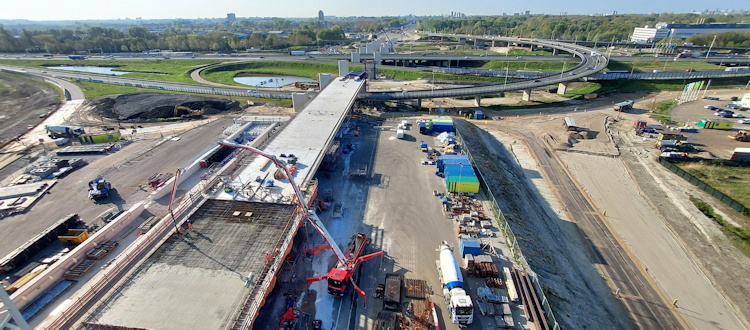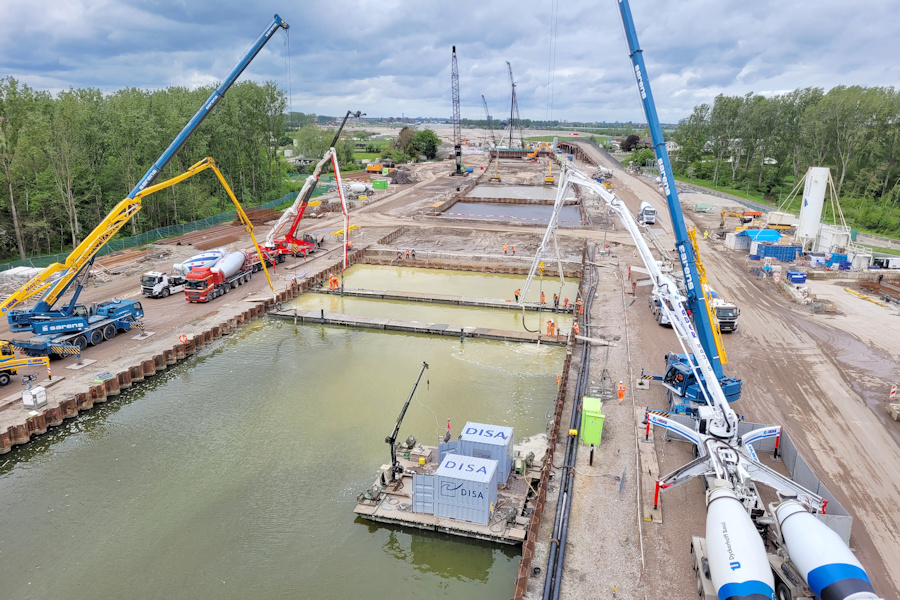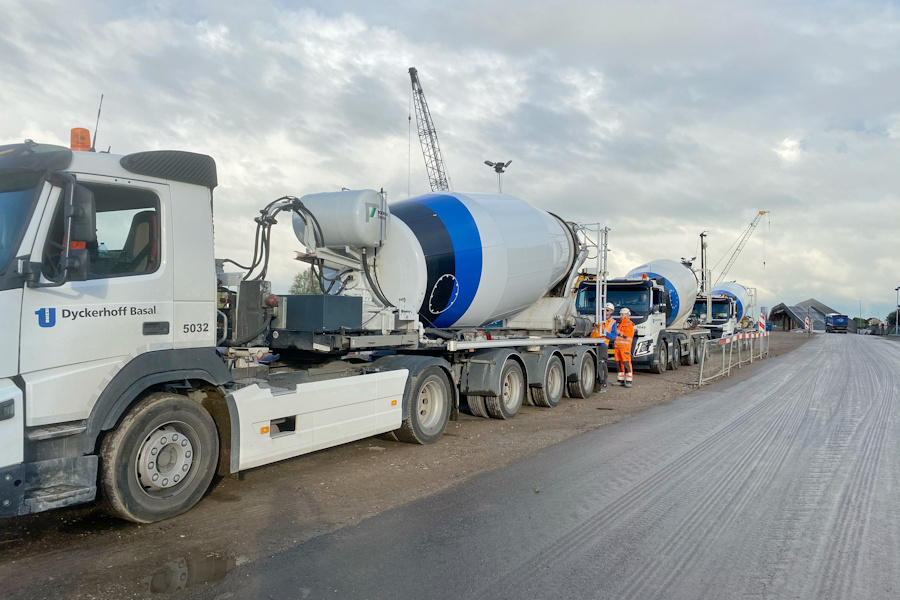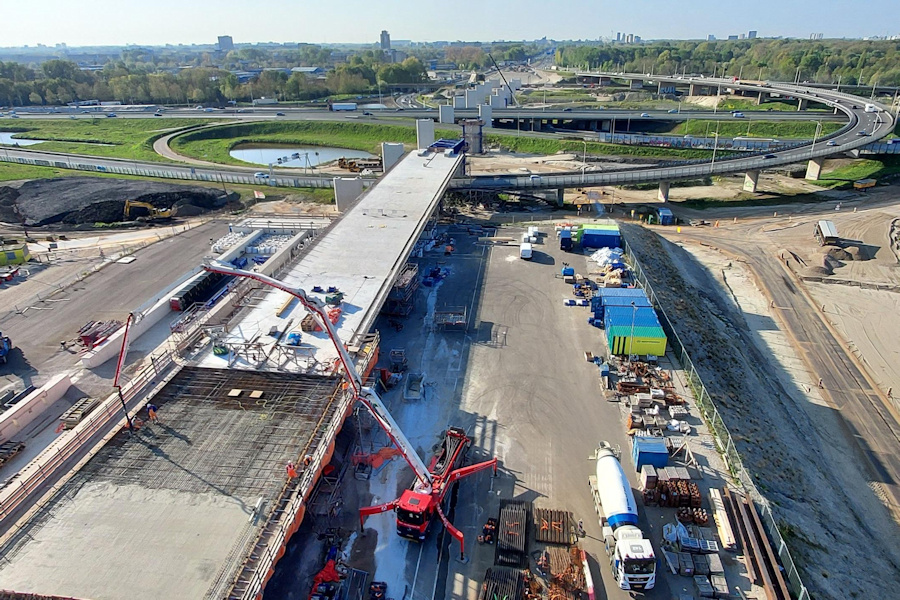Project A16 "De Groene Boog"

26 July 2023
Important transport infrastructure project with high standards of sustainability to improve access to the Rotterdam region – built with concrete from Dyckerhoff Basal
In the north of Rotterdam, the project A16, an eleven kilometers long extension of the A16 highway, will soon connect the A13 highway at the Rotterdam The Hague Airport to the Terbregseplein highway junction of A16 and A20. Thereby traffic on both, the A13 and the A20, and on parts of the local road network will be reduced. Commuting from and to the airport thus will be much easier and faster, and access to the Rotterdam region will improve significantly. The project will also include the construction of a tunnel that has a length of 2.2 kilometers, as well as three railway crossings and the construction of a 400 meters long viaduct Terbregseplein. To meet the sustainability requirement, the road is incorporated into the landscape as effectively and seamlessly as possible. The Dutch ministry Rijkswaterstaat has commissioned the consortium De Groene Boog with the designing, financing, construction and subsequent 20 years maintenance of the new A16. Work began in 2019 and is expected to continue until the end of 2024.
In terms of its operation, the already mentioned tunnel is the first energy-neutral highway tunnel of the world. Solar panels will generate all the energy required to operate the roadside and tunnel lighting, as well as all other tunnel installations. Additionally, the fact that the highway crosses a highly populated area, leads to seeking out innovative solutions. With the tunnel going both under the river Rotte and the recreation area Lage Bergse Bos, exceptionally quiet asphalt and sound-absorbing noise barriers, the A16 Rotterdam will be one of the best integrated national roads in the Netherlands.
The construction methods for the tunnel and the viaduct over Terbregseplein are rather spectacular because they are extraordinary by Dutch standards. In the Rottemerentunnel, almost the entire tunnel floor consists of a reinforced underwater concrete floor. At the busy traffic junction Terbregseplein, the viaduct is built using the so-called Incremental Launching Method, which is the first time in the Netherlands at a road crossing in operation. This means, a complete bridge deck – one for each direction of travel – is "pushed" from one side to the other – over the complete length of the bridge. The concrete segments were launched while traffic on the highways A20 and A16 below could continue to drive.
Total quantity of concrete to be processed is around 400,000 m³, which is produced in five Dyckerhoff Basal concrete plants in Delft, Rotterdam, Dordrecht, Den Haag and Nieuwegein. So far, concrete of various strength classes has been delivered ranging from C12/15 to C60/75 in different consistencies up to self-compacting concrete. Around three quarters of the concrete supplied has been of standard strengths C30/37 and C35/45, more than 90 % of which was of F4 consistencies (very soft) or flowable up to self-compacting (SF2). In total, over 85 % of the delivered concrete amounted to concrete of higher consistencies – F4, F5 and self-compacting concrete.
Various cements from German Dyckerhoff plants were used to produce the different types of concrete processed in the project, mainly the blast-furnace cements AQUADUR Doppel [CEM III/B 42.5 N-LH/SR (na)] from Neuss and ECODUR [CEM III/B 42.5 L-LH/SR (na)] from Neuwied. For special early strength requirements, however, additionally Portland cements PZ Dreifach [CEM I 52.5 R] from the Lengerich and Geseke cement plants were also used.
Overall, the CO2 footprint (GWPnet) of the AQUADUR Doppel is approx. 52 % and of the ECODUR approx. 55 % lower than that of an average Portland cement of strength class 42.5. CEM III/B cements, such as ECODUR, have a particularly low clinker content and contain high amounts of blast-furnace slag as the main constituent. Due to their low development of hydration heat, they are well suited for special requirements such as massive components and offer high resistance to chemical attack and chlorides penetrating into the concrete.
The scale of the project demanded large deliveries over a long period of time. There were about 33 underwater concrete deliveries with a total of about 126,500 m³. The largest orders where about 12,000 m³ to be delivered within three days. During this time, Dyckerhoff Basal managed to shoulder an above-average consumption of cement and concrete and to provide sufficient personnel to fulfill the demanding task.

About 33 underwater concrete deliveries with a total of about 126,500 m³ were needed to build the Rottemerentunnel.

The eleven kilometers long extension of the A16 highway is built with around 400,000 m³ concrete from Dyckerhoff Basal.

The Incremental Launching Method is used to build the Terbregseplein viaduct – a premier in the Netherlands at a road crossing still in operation.


